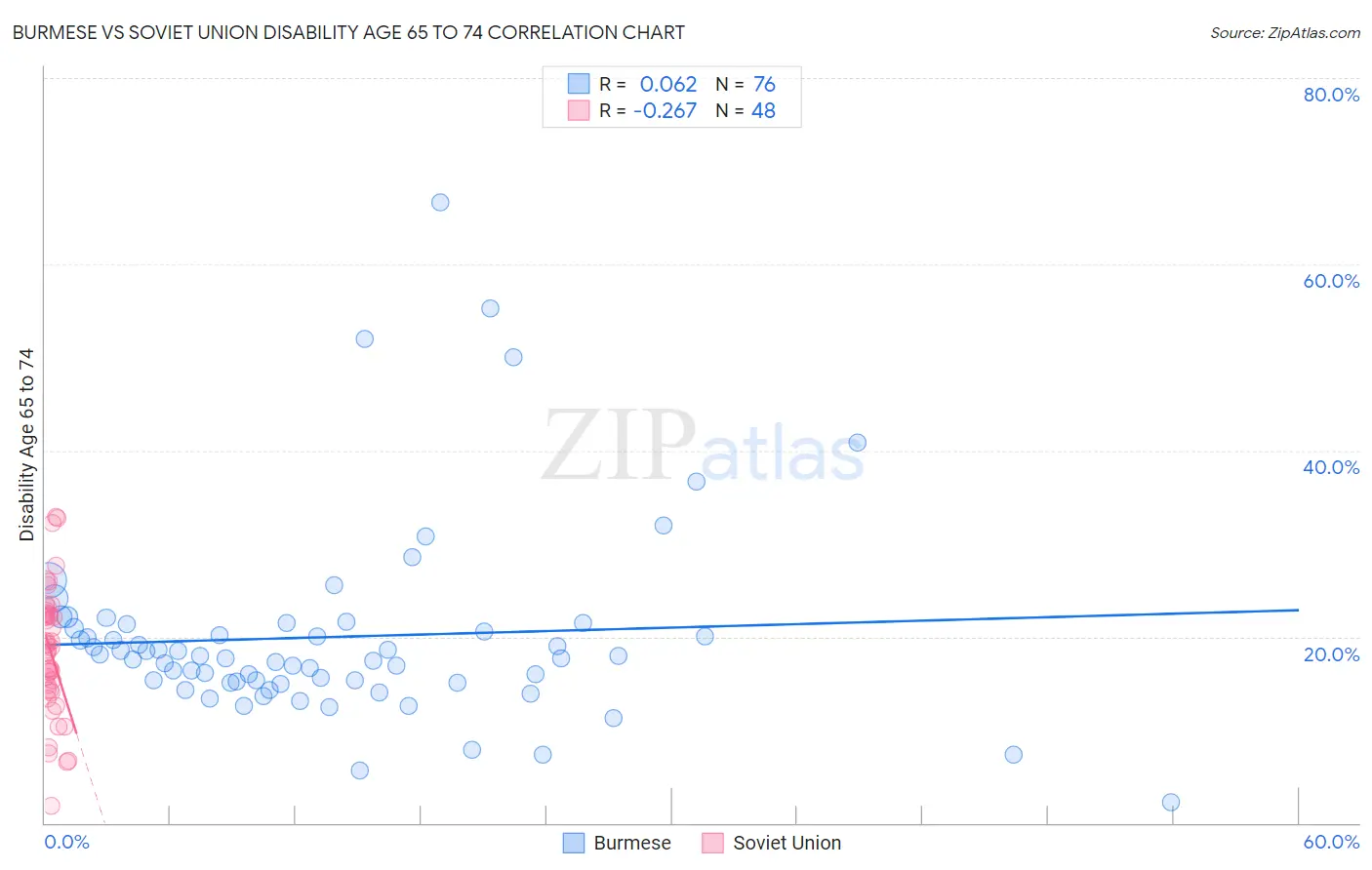Burmese vs Soviet Union Disability Age 65 to 74
COMPARE
Burmese
Soviet Union
Disability Age 65 to 74
Disability Age 65 to 74 Comparison
Burmese
Soviet Union
20.6%
DISABILITY AGE 65 TO 74
100.0/ 100
METRIC RATING
19th/ 347
METRIC RANK
21.0%
DISABILITY AGE 65 TO 74
99.9/ 100
METRIC RATING
24th/ 347
METRIC RANK
Burmese vs Soviet Union Disability Age 65 to 74 Correlation Chart
The statistical analysis conducted on geographies consisting of 463,915,449 people shows a slight positive correlation between the proportion of Burmese and percentage of population with a disability between the ages 65 and 75 in the United States with a correlation coefficient (R) of 0.062 and weighted average of 20.6%. Similarly, the statistical analysis conducted on geographies consisting of 43,509,359 people shows a weak negative correlation between the proportion of Soviet Union and percentage of population with a disability between the ages 65 and 75 in the United States with a correlation coefficient (R) of -0.267 and weighted average of 21.0%, a difference of 1.6%.

Disability Age 65 to 74 Correlation Summary
| Measurement | Burmese | Soviet Union |
| Minimum | 2.2% | 1.8% |
| Maximum | 66.7% | 32.9% |
| Range | 64.5% | 31.0% |
| Mean | 20.0% | 18.4% |
| Median | 17.8% | 18.7% |
| Interquartile 25% (IQ1) | 15.2% | 14.3% |
| Interquartile 75% (IQ3) | 21.1% | 22.4% |
| Interquartile Range (IQR) | 5.9% | 8.2% |
| Standard Deviation (Sample) | 10.6% | 6.8% |
| Standard Deviation (Population) | 10.5% | 6.7% |
Demographics Similar to Burmese and Soviet Union by Disability Age 65 to 74
In terms of disability age 65 to 74, the demographic groups most similar to Burmese are Eastern European (20.6%, a difference of 0.030%), Immigrants from South Central Asia (20.6%, a difference of 0.10%), Okinawan (20.7%, a difference of 0.32%), Immigrants from Lithuania (20.5%, a difference of 0.35%), and Paraguayan (20.5%, a difference of 0.41%). Similarly, the demographic groups most similar to Soviet Union are Bolivian (21.0%, a difference of 0.040%), Immigrants from Belgium (21.0%, a difference of 0.050%), Immigrants from Australia (21.0%, a difference of 0.060%), Immigrants from Sweden (21.0%, a difference of 0.080%), and Immigrants from Czechoslovakia (21.0%, a difference of 0.18%).
| Demographics | Rating | Rank | Disability Age 65 to 74 |
| Immigrants | Ireland | 100.0 /100 | #11 | Exceptional 20.3% |
| Immigrants | Korea | 100.0 /100 | #12 | Exceptional 20.4% |
| Immigrants | Singapore | 100.0 /100 | #13 | Exceptional 20.4% |
| Indians (Asian) | 100.0 /100 | #14 | Exceptional 20.5% |
| Paraguayans | 100.0 /100 | #15 | Exceptional 20.5% |
| Immigrants | Lithuania | 100.0 /100 | #16 | Exceptional 20.5% |
| Immigrants | South Central Asia | 100.0 /100 | #17 | Exceptional 20.6% |
| Eastern Europeans | 100.0 /100 | #18 | Exceptional 20.6% |
| Burmese | 100.0 /100 | #19 | Exceptional 20.6% |
| Okinawans | 100.0 /100 | #20 | Exceptional 20.7% |
| Immigrants | Bolivia | 99.9 /100 | #21 | Exceptional 20.8% |
| Immigrants | Iran | 99.9 /100 | #22 | Exceptional 20.9% |
| Immigrants | Belgium | 99.9 /100 | #23 | Exceptional 21.0% |
| Soviet Union | 99.9 /100 | #24 | Exceptional 21.0% |
| Bolivians | 99.9 /100 | #25 | Exceptional 21.0% |
| Immigrants | Australia | 99.9 /100 | #26 | Exceptional 21.0% |
| Immigrants | Sweden | 99.9 /100 | #27 | Exceptional 21.0% |
| Immigrants | Czechoslovakia | 99.9 /100 | #28 | Exceptional 21.0% |
| Immigrants | Japan | 99.9 /100 | #29 | Exceptional 21.0% |
| Immigrants | Greece | 99.9 /100 | #30 | Exceptional 21.0% |
| Immigrants | Northern Europe | 99.9 /100 | #31 | Exceptional 21.0% |